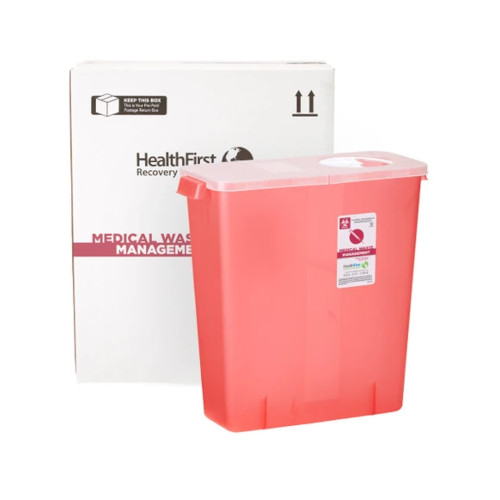Environmental Responsibility: The Eco-Friendly Method to Medical Waste Disposal
Wiki Article
Checking Out Different Garbage Disposal Options for a Cleaner Setting
In the pursuit of a cleaner environment, the management of waste disposal has become a vital focal factor for lasting development. With a wide variety of garbage disposal alternatives available, varying from typical landfill techniques to cutting-edge waste-to-energy technologies, the choice of how we manage our waste has significant implications for our earth's health. By checking out the numerous techniques and techniques employed in recycling, composting, incineration, land fill management, and waste-to-energy processes, a much deeper understanding of their influences and effectiveness can be gained. The quest for ideal garbage disposal approaches that focus on environmental preservation while satisfying the needs of a growing populace remains a pushing concern in today's world.Recycling Approaches
Applying efficient recycling approaches is critical in minimizing waste and advertising sustainability in our environment. Reusing involves the procedure of converting waste products into multiple-use challenge stop unneeded disposal. Among the most common recycling techniques is worldly recovery, where products like paper, plastic, metal, and glass are gathered, arranged, and refined to develop brand-new items. This process not just conserves natural deposits yet likewise minimizes power intake and greenhouse gas exhausts linked with creating new products from the ground up.Another essential recycling approach is composting, which involves disintegrating natural waste like food scraps and lawn trimmings right into nutrient-rich soil. This process not only draws away natural waste from garbage dumps however additionally produces a useful resource for gardening and agriculture. Additionally, upcycling is an imaginative recycling approach that includes changing old or discarded materials right into products of better or value. By including these various reusing techniques into our waste monitoring techniques, we can dramatically reduce our ecological footprint and relocate in the direction of an extra lasting future.

Composting Methods
Reliable waste management methods, such as reusing approaches, lead the means for a cleaner environment, and currently, shifting the emphasis to 'Composting Techniques', we explore sustainable means to break down natural waste for ecological benefit. medical waste disposal.Composting is a natural procedure that changes natural waste, like food scraps and yard trimmings, into a nutrient-rich soil modification. The key to effective composting hinges on creating the best equilibrium of green products, such as vegetables and fruit scraps, and brown products, like dried leaves and branches. These materials decay with the aid of microbes, damaging down the waste into beneficial compost.
There are numerous composting methods available to fit different demands. Traditional yard composting includes layering organic materials in a container or pile and routinely transforming the blend to freshen it. Vermicomposting, on the various other hand, utilizes worms to break down raw material right into garden compost (click here). For those with limited area, indoor composting systems offer a practical remedy. By utilizing composting methods, we can reduce the quantity of waste sent out to land fills while producing a helpful item for enriching soil and supporting plant development.
Incineration Pros and Disadvantages
Incineration, as a waste disposal method, provides both benefits and disadvantages that merit cautious factor to consider in the world of sustainable waste monitoring methods. On the positive side, incineration can dramatically lower the volume of waste, minimizing the requirement for land fill area and possibly reducing greenhouse gas discharges.In addition, the high preliminary financial investment and operational prices of incineration facilities posture financial challenges, making it a much less economical option compared to various other waste monitoring strategies. Mindful tracking and policy are crucial to minimize these negative influences and maximize the advantages of incineration as component of a comprehensive waste monitoring method.
Land Fill Monitoring Approaches
Land fills play a crucial function in waste monitoring and ecological conservation by supplying a containment system for the disposal of strong waste products. By condensing the waste, the volume is lowered, permitting for more waste to be suited over time.Additionally, the implementation of day-to-day cover methods is important in reducing odors, preventing clutter, and decreasing the tourist attraction of insects. Treatment the disposed waste at the end of each day helps to consist of odors and prevent potential environmental contamination. Furthermore, the monitoring of landfill gas exhausts and leachate degrees is important in guaranteeing that ecological standards are satisfied which any possible risks to surrounding communities are minimized.

Waste-to-Energy Technologies
Among the innovative methods to throw away monitoring involves taking advantage of Waste-to-Energy innovations to convert strong waste into usable energy sources. Waste-to-Energy (WtE) modern technologies encompass a variety of procedures that aim to extract power from waste products via thermal, chemical, or organic means. This conversion process not just decreases the quantity of waste that ends up in garbage dumps yet likewise creates useful energy resources such as electricity, heat, or biofuels.There are a number of approaches of Waste-to-Energy conversion, consisting of incineration, pyrolysis, and gasification. Incineration involves burning waste at heats to create warmth and click here power. Gasification transforms waste right into a syngas, which can be used for power generation or chemical manufacturing. Pyrolysis breaks down natural materials using heats in the lack of oxygen, creating gas, char, and bio-oil.
Implementing Waste-to-Energy modern technologies can aid reduce ecological concerns connected with conventional garbage disposal approaches while simultaneously providing a sustainable power source. Nonetheless, cautious factor to consider has to be given to emissions control and ensuring the sustainability of feedstock supplies for these innovations to be absolutely valuable for a cleaner environment.

Final Thought
Finally, discovering various garbage disposal options such as recycling, composting, incineration, landfill management, and waste-to-energy innovations is vital for advertising a cleaner setting - click here. Each approach has its very own benefits and obstacles, yet by using a mix of these methods, we can function towards reducing the amount of waste that finishes up in land fills and eventually add to an extra lasting future for generations aheadWith a plethora of waste disposal options readily available, ranging from conventional landfill techniques to innovative waste-to-energy technologies, the option of how we handle our waste has far-ranging ramifications for our earth's well-being. medical waste disposal.Incineration, as a waste disposal method, offers both benefits and disadvantages that warrant careful consideration in the realm of lasting waste monitoring methods.Landfills play a critical role in waste monitoring and ecological preservation by giving a control system for the disposal of strong waste materials. By compacting the waste, the quantity is minimized, permitting for even more waste to be fit over time
One of the ingenious techniques to throw away monitoring involves taking advantage of Waste-to-Energy modern technologies to convert solid waste into useful power resources.
Report this wiki page